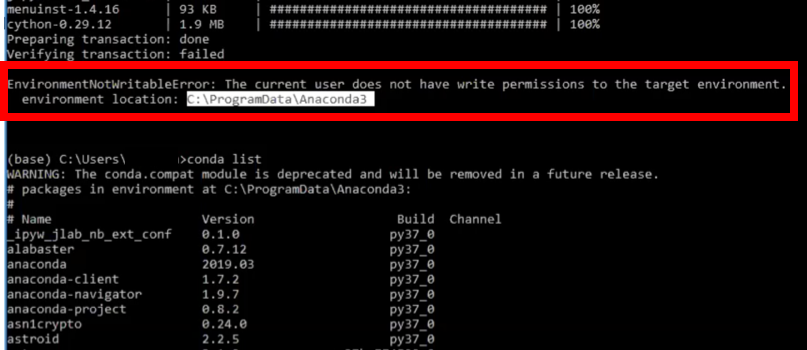

- Run aws cli from anaconda prompt how to#
- Run aws cli from anaconda prompt install#
- Run aws cli from anaconda prompt download#
AWS currently has three partitions: aws (Standard Regions), aws-cn (China Regions), and aws-us-gov (AWS GovCloud Regions). Bucket names must be unique within a partition.Bucket names can’t begin with xn- (for buckets created after February 2020).Bucket names must not be formatted as an IP address (for example, 192.168.5.4).Bucket names must begin and end with a letter or number.Bucket names can consist only of lowercase letters, numbers, dots (.), and hyphens (-).Bucket names must be between 3 and 63 characters long.The following rules apply for naming S3 buckets: Let’s outline the Rules for bucket naming: Rules for bucket naming
Run aws cli from anaconda prompt how to#
How to create a bucket $ aws s3 mb s3://bucket-nameīear in mind that there are some restrictions in Bucket Names. In case you want to list for a specific bucket: aws s3 ls s3://bucket-nameįor example, if you want help for the s3api or s3: $ aws s3api help How to list the S3 buckets aws s3api list-buckets This file contains the configuration settings for the default profile and any named profiles. The config file is located at ~/.aws/config on Linux or macOS, or at C:\Users\ USERNAME\.aws\config on Windows. The credentials and config file are updated when you run the command aws configure. This file can contain the credential details for the default profile and any named profiles CLI configuration file The credentials file is located at ~/.aws/credentials on Linux or macOS, or at C:\Users\ USERNAME\.aws\credentials on Windows. Close and restart the command shell to see the effects of the change. It does not affect any command shell that is already running at the time you run the command. Using setx to set an environment variable changes the value in all command shells that you create after running the command. Using set to set an environment variable changes the value used until the end of the current command prompt session, or until you set the variable to a different value. Linux or macOS $ export AWS_PROFILE=user1 If you do not want to add the - profile username in every single command when you are dealing with different users, you can set the AWS_PROFILE environment variable at the command line. You can then specify a -profile profilename and use the credentials and settings stored under that name : $ aws s3 ls -profile produser $ aws configure -profile produserĪWS Access Key ID : AKIAI44QH8DHBEXAMPLEĪWS Secret Access Key : je7MtGbClwBF/2Zp9Utk/h3圜o8nvbEXAMPLEKEY The following example creates a profile named produser. You can create and use additional named profiles with varying credentials and settings by specifying the -profile option and assigning a name. By default, the AWS CLI uses the default profile. You can create different users by applying profiles. You can do it from the command line (I use Anaconda) with the configurecommand where you create the credentials file: $ aws configureĪWS Access Key ID : YOUR_ACCESS_KEYĪWS Secret Access Key : YOUR_SECRET_ACCESS There are several ways to configure the aws. Once you installed it you can get the version with the command:Īws -version How to Configure the AWS CLI
Run aws cli from anaconda prompt install#
Since we work with Python, I would suggest to pip install the awsclipackage from the Anaconda distribution.
Run aws cli from anaconda prompt download#
With just one tool to download and configure, you can control multiple AWS services from the command line and automate them through scripts. The AWS Command Line Interface (CLI) is a unified tool to manage your AWS services. If you do not feel comfortable with the command lines you can jumpy to the Basic Introduction to Boto3 tutorial where we explained how you can interact with S3 using Boto3. I believe that the following examples are the basics needed by a Data Scientist working with AWS. At this post, I gather some useful commands/examples from AWS official documentation.


 0 kommentar(er)
0 kommentar(er)
